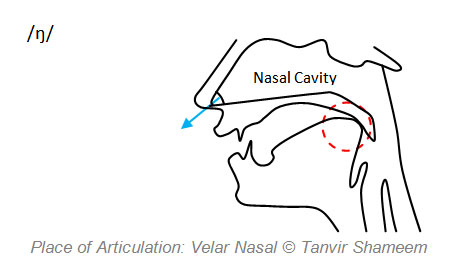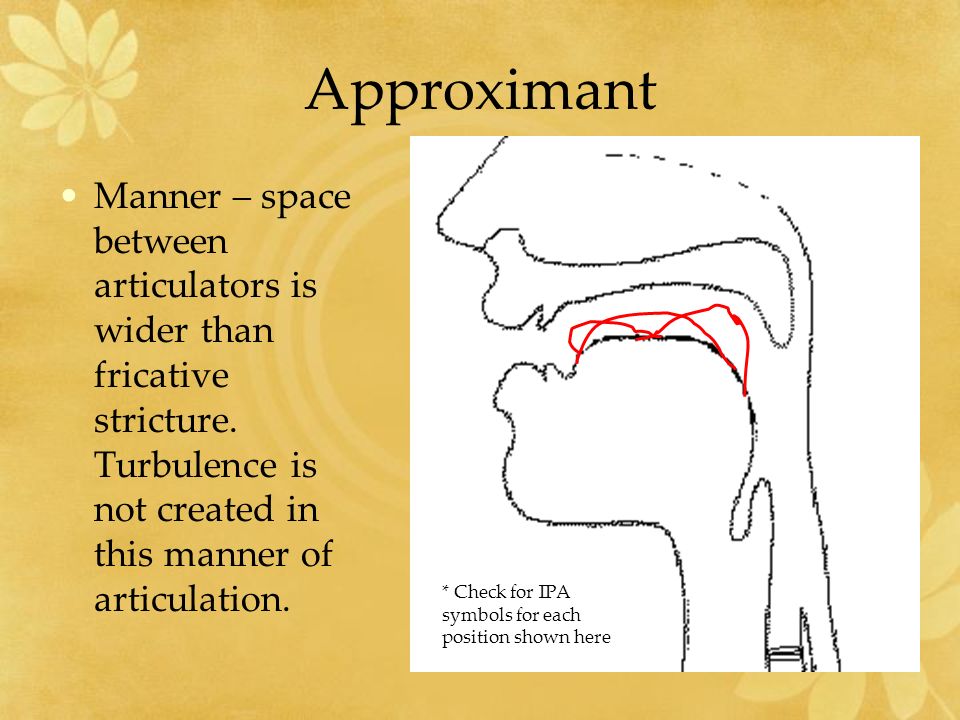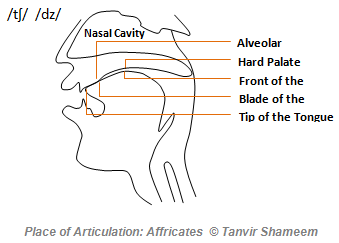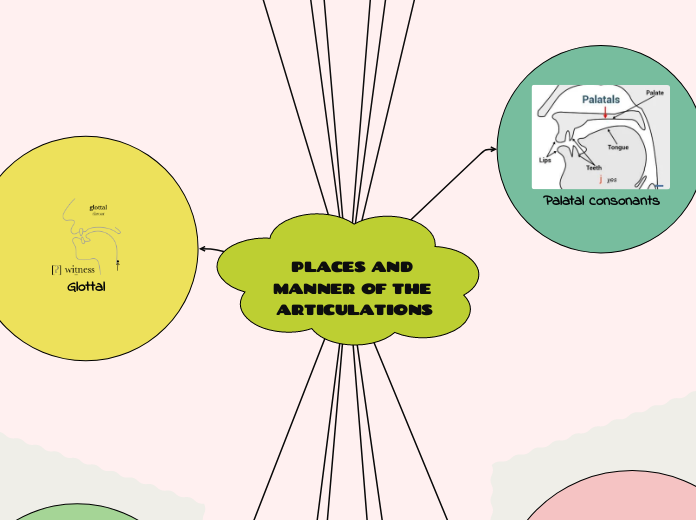PLACES AND MANNER OF THE ARTICULATIONS

Alveolar consonants
Sounds production
Raise the tongue to the alveolar ridge to
block the airflow
An alveolar consonant sound is produced when the obstruction to airflow takes place at the alveolar ridge. The airflow obstruction is caused by the tongue and the way it makes contact with the alveolar ridge
t tie
d die
n night
l light
z zoo
s sue
8 types of alveoral consonant sounds
Alveolar Plosive
Alveolar Nasal
Alveolar Fricative
Alveolar Approximant
Alveolar Lateral Approximant

Velar consonants
Behind your hard palate you have the velum or soft palate. Unlike the bony hard palate in front of it, the this consists of soft, mucousy tissue
sounds
k
curl
g
girl
ŋ
rang
You make Velar Consonants when you raise the back of your tongue to the velum to block or restrict airflow

Post-alveolar / palato-alveolar consonants
Sounds production:
The tongue blocks the airflow at the point just
beyond the alveolar ridge
ʃ shoe, pressure
Ʒ pleasure
ʧ cheap
ʤ jeep
Post-alveolar consonants are those that occur when the tongue blocks or constricts airflow at the point just beyond the alveolar ridge

Palatal consonants
You create Palatal consonants when you raise the tongue to this point and constrict airflow
/j/ as in yes and bayou
The roof of your mouth is the hard palate. You may know it as “the place that burns like hell when I eat pizza that is too hot''

NASAL
Nasal consonants are created when you completely block air flow through your mouth and let the air pass through your nose
There are three nasal consonants
/m/ – “mad” and “clam” – oral passage is blocked by closing the lips (bilabial)
/n/ – “no” and “man‘ – oral passage is blocked by pressing tongue tip against the alveolar ridge (alveolar)
/ŋ/ – “going” and “funk” – Oral passage is blocked by pressing the the back of your tongue against the soft palate (velar)

Fricative
Fricative sounds involve only a partial blockage of the vocal tract so that air has to be forced through a narrow channel
The English fricative sounds are as follows:
/s/ – “suit” – air is forced through tongue and alveolar ridge (alveolar)
/z/ –''jazz” – air is forced through tongue and alveolar ridge (alveolar)
/ʃ/ –''brash” – air is forced through the tongue and point just beyond alveolar ridge (post-alveolar) /ʒ/ – “measure” – air is forced through the tongue and point just beyond alveolar ridge (post-alveolar)
/θ/ – “thick” – air is forced through upper teeth and tongue (dental)
/ð/ – rather” – air is forced through upper teeth and tongue (dental)
/h/ – “happy”– actually /h/ isn’t a fricative. It’s technically not even a real consonant sound since there’s no constriction/obstruction of airflow
/f/ – “fro” and “calf“- air is forced through the upper teeth and lower lip (labiodental)
/v/ – “vine” – air is forced through the upper teeth and lower lip (labiodental)

Aproximant
There are three English approximants:
/w/ – “wet” and “howard” – back of tongue raises to velum (but not too close!) and lips are rounded (velar)
Approximants are when two articulators come close together but not quite close enough to create air turbulence
/j/ – “yes” and “bayou” – tongue raises to hard palate (but not too close!) (palatal)
/ɹ/ – “right” and “roar” – tongue raises to hard palate (but not too close) (alveolar/post-alveolar)

Dental consonants
Sounds production:
block the airflow by placing the slimy tongue
against the upper teeth
θ thin
ð this
The dental consonants are so named because they are all made with the tongue against the teeth

Add your text

bilabial consonants
Sounds production:
block the airflow out of the
mouth by bringing the lips
together
[P] When you produce a voiceless bilabial plosive [p] you completely close the lips for a short period. Example: apple
The [B] sound does not have an air escape like “p.Remind the child to cover “the lips. Example: buy
[M]Place one finger on a horizontal surface under your lower lip or slide it over your lips. Example: mute
[W] a voiced labial velar approximant. It's produced like a very short [u] vowel. Example: wood

Labiodental consonants
Sounds production:
block the airflow by curling the
lower lip back and raising it to
touch the upper row teeth
F free - /fɹi:/
The partial obstruction in the case of the /f/ and /v/ sounds is caused by the teeth making contact with the lip, causing only small gaps for air to be released in between the teeth
V view - /vju:/

Glottal

Glottal
/h/ as in “hi” and “Bahamas.” Say these words and notice how you’re not actually constricting or blocking airflow for this /h/ sound
H: hi
/?/ – This is actually the culprit behind many of the “silent syllables”
ʔ kitten

STOP
stop consonants occur when the vocal tract is closed completely
English contains the following stop consonants
/p/ – purse and rap – oral passage is blocked by closing the lips (bilabial)
/b/ – “cab” – oral passage is blocked by closing the lips (bilabial)
/t/ – “tab” and “rat” – oral passage is blocked by pressing the tongue tip against the alveolar ridge (alveolar)
/d/ – “dip” and “bad” – oral passage is blocked by pressing the tongue tip against the alveolar ridge (alveolar)
/k/ – “kite” and “back” – block airflow with the back of the tongue against the soft palate (velar)
/g/ – “good” and “bug” – block airflow with the back of the tongue against the soft palate (velar)

Africatte
The English affricate sounds are:
ffricate consonants start as stop sounds with air building up behind an articulator which then releases through a narrow channel as a fricative
/tʃ/ – “chick” – air is blocked with tongue just beyond the alveolar ridge (post-alveolar), then released as a fricative.
/dʒ/ – “jam” – air is blocked with tongue just beyond the alveolar ridge (post-alveolar), then released as a fricative.

Add your text
Lateral consonants are when the tongue blocks the the middle of your mouth so that air has to pass around the sides
Here is one lateral consonant in English:
l/ – “luck”- place the tip of the tongue at the alveolar ridge (alveolar)
